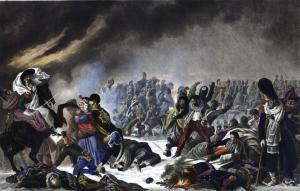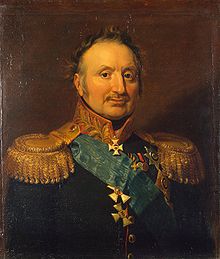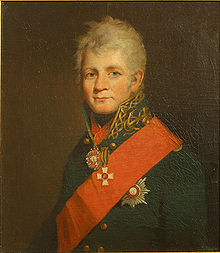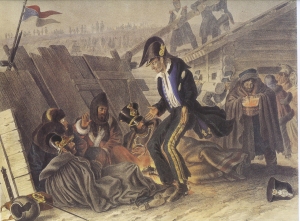Faber du Faur wrote extensively on the events of the 28th which accompanied his painting of the same date.
Crossing of the Beresina, 28 November
“Meanwhile, as night fell, the crowds of people who had not crossed on the 27th grew silent. They settled down among the ruins of Studianka, along the heights or in amongst the mass of wagons and vehicles now forming an immense and virtually impenetrable ring around the bridges. Campfires illuminated the entire area. The majority of these unfortunates, worn down by their privations, had grown insensible to suffering or believed themselves protected by [Marshal Claude] Victor‘s corps, the left flank of which had taken up position on the Studianka heights.”
“Thus it was that the night of the 27th passed by. Artillery fire, which broke out on both banks simultaneously, heralded the dawn of the 28th. [Count Peter ] Wittgenstein, with 40,000 Russians, was bearing down upon us from the direction of Borisov, whilst [Pavel] Chichagov, with 27,000 men, was attempting to attack the bridges on the right bank For most of the unfortunates on the left bank the final hour had come. They rose up and threw themselves towards the bridges. The bridge on the left, intended for guns and wagons, collapsed for the third time under the weight of the fugitives, and any attempt to repair it was frustrated by the subsequent disorder and confusion.”
“A single idea took hold of the crowd, a single objective: to reach the bridge. And in order to do so the fugitives were prepared to crush every obstacle and force their way past anyone, be it friend, commander, woman or child. People were thrust into the freezing waters of the Beresina or pushed into the flames of the burning house between the two bridges.”
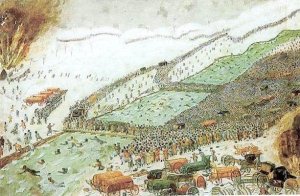
De Overtocht van de Berexina
by Aquarel van Fournier, an eyewitness
“Victor, his corps now reduced to 6,000 men, made heroic efforts to stem Wittgenstein’s advance, whilst [Marshal Nicolas] Oudinot, [Marshal Michel] Ney and [Jean Henri] Dombrowski managed to push Chichagov back on Stakova. Even so, Wittgenstein, with vastly superior numbers, was gradually pushing Victor back towards the bridges, so much so that he was able to bring artillery fire to bear on the crowds of fugitives struggling to reach the crossing. The desperation of this mass reached fever pitch. Each Russian shell or round shot found a target, and swathese of unfortunates were cut down. The cries of the multitude muffled the sound of the artillery as they made a supreme effort. In a convulsed wave they surged forward, crushing the dead and dying underfoot. Finally night fell and the Russian artillery fire first grew sporadic before ceasing altogether. Towards nine in the evening Victor’s corps forced a passage through a scene of desolation and passed over to the right bank, leaving a rearguard in Studianka.”
“A good number of unfortunates failed to take the opportunity of crossing with relative ease and on the morning of the 29th woke to find the Russians advancing and a vast crowd milling around the bridges. It was all for nothing as, at 8:30, the bridges were set on fire and all means of crossing the river went up in flames. The same fate would have befallen all those who had crossed over to the right bank had Chichagov destroyed the series of bridges which spanned the marshes between Zaniviki and Zembin. Fortunately, he failed to realise the importance of this defile and we arrived at Zembin having ourselves destroyed the bridges and placed the marsh between ourselves and the pursuing enemy.”
Source:
With Napoleon in Russia: The Illustrated Memoirs of Major Faber du Faur, 1812, edited by Jonathan North

